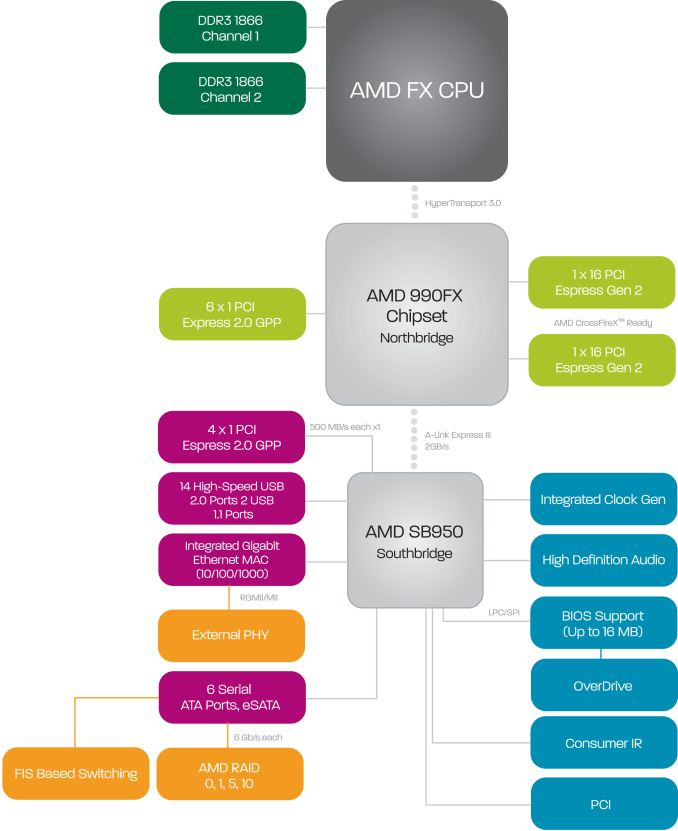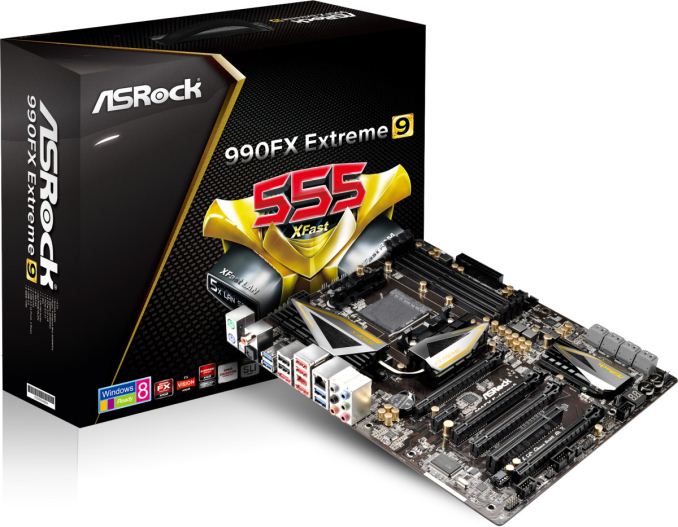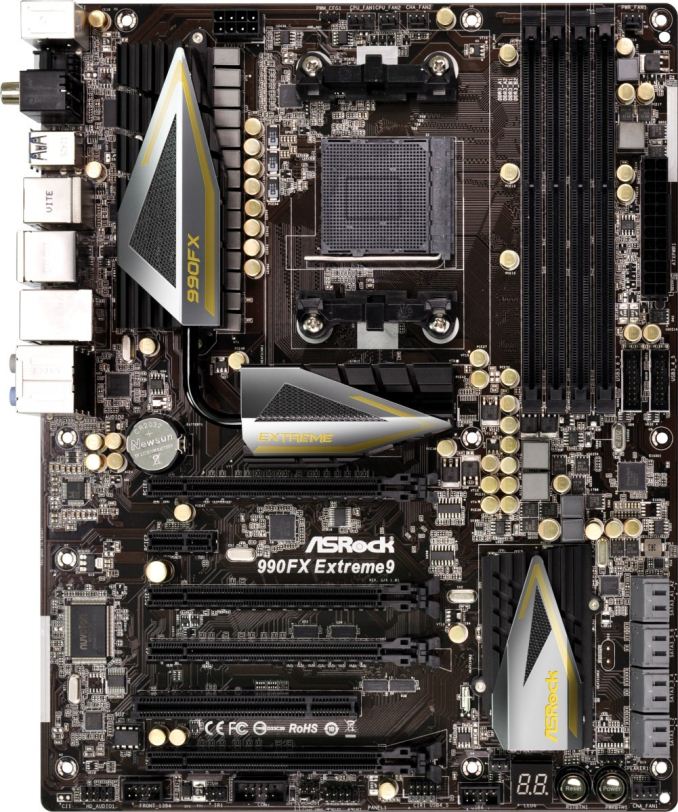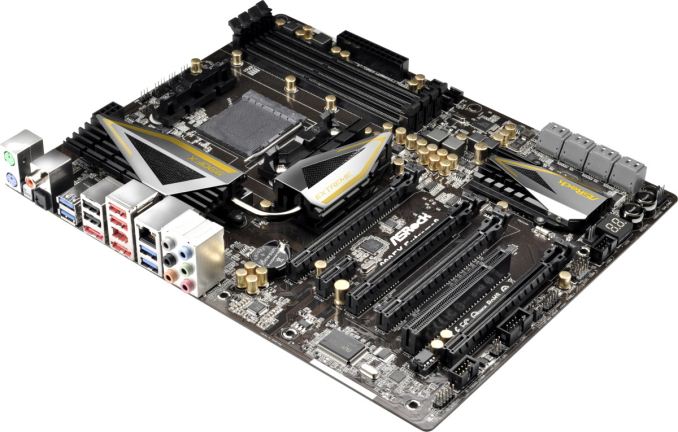AMD’s 5 GHz Turbo CPU in Retail: The FX-9590 and ASRock 990FX Extreme9 Review
by Ian Cutress on August 9, 2014 8:00 AM ESTFor new users to the PC industry, or those that migrated towards newer APU platforms, it is worth going back and recalling the AM3+ socket with the 990FX chipset. When the platform was released, it offered several advantages that Intel lacked at the time: a full set of SATA 6 Gbps ports was the main advantage which took Intel another two generations to offer. The chipset, with the right CPU, also offered substantially more PCIe lanes than the mainstream Intel parts which were similarly priced. While the user could have sixteen PCIe 2.0 lanes from an Intel CPU for graphics coupled with eight PCIe 2.0 lanes from the chipset, AMD users had 32 PCIe 2.0 lanes from the CPU for graphics, another six PCIe 2.0 x1 lanes for controllers and four PCIe 2.0 x1 lanes from the chipset. This gave the AMD motherboard manufacturers more bandwidth to add extra ports or adjust their PCIe layout for graphics. Note that this is the latest AMD platform to support SLI, rather than the newer FM1/FM2 platforms that do not.
There are a few limitations on the 990FX chipset worth mentioning. When this motherboard we are testing today was released, PCIe 3.0 was gaining momentum. The only way to add PCIe 3.0 to these motherboards was to integrate a PLX chip between the Northbridge and the GPUs which gave PCIe 3.0 capabilities between the GPUs, but it still limited data transfer between the PLX chip and the CPU to PCIe 2.0. The other limitation was one of cost. AMD platforms have historically been low cost markets, at least for end users, which correlates to a reluctance to expand spending on motherboards. This reduces the market for high end motherboard solutions which might incorporate extra features and controllers, and as a result many AM3+ motherboards were aimed at price/performance rather than feature set.
The ASRock 990FX Extreme9 sits near the top of the stack for feature set, and currently retails for $170. To put that into perspective, we discuss $170 motherboards for Intel’s latest chipsets as a mid-range point rather than the high end.
Also worth noting that because our last 990FX reviews were with the FX-8150 processor, in order to compare to historical data we also used the Extreme9 with the FX-8150 for comparison points.
ASRock 990FX Extreme9 Overview
Visual Inspection
Taking the motherboard out of the box for the first time and there are several items worth noting. Firstly the extended heatsink which covers the 12+2 phase power delivery to the side of the socket and the North Bridge just below the socket. ASRock has placed all the power delivery chokes in a line, and uses a CHIL8328 IC for a digital design. This PWM controller powers 6-8 phases, and thus the system uses multiplexing to get the desired 12 for the CPU voltage.
The socket area has four fan headers within immediate reach – two CPU and one chassis header directly above the socket, and a 3-pin PWR header to the top right of the DRAM slots. The other two fan headers on the motherboard are located at the bottom, one to the left of the 2-digit debug and the other to the right of the power/reset buttons. The socket area uses a low heatsink profile combined with a gap to the DRAM that should allow for large air coolers to be used.
The DRAM slots use double sided latch mechanisms and there is ample space to the first major PCIe slot. At the bottom of the DRAM slots, to the right, are two USB 3.0 headers from an Etron EJ188H controller. At the time this motherboard was made, a chassis may have had one USB 3.0 header, and thus ASRock also includes a USB 3.0 panel in the box.
Underneath this are eight SATA 6 Gbps ports, the top two from an ASMedia ASM1061 controller followed by six from the south bridge. In this situation, with an additional controller, I would have preferred if ASRock had used a different color for the ASMedia ports. Below these is a fan header, the power and reset buttons, and the two-digit debug.
At the bottom of the motherboard is an IEEE1394 header, a COM header, two USB 2.0 headers, an IR header and the front panel headers. Above this is the odd PCIe layout, which combines the 32 PCIe 2.0 lanes from the north bridge with another PCIe 2.0 x4.
The layout is such that the top PCIe slot is an x16, followed by an x1. The second full length slot is a PCIe 2.0 x4, followed by another PCIe 2.0 x16. This slot shares bandwidth with the bottom PCIe slot, whereby if the bottom is populated, they both go to PCIe 2.0 x8. There is also a PCI slot near the bottom.
This means:
Configuration 1: x16/x1/x4/x16/PCI/-
Configuration 2: x16/x1/x4/x8/PCI/x8
Having this layout allows the user to equip the board with three GPUs in the first, third and fourth full length slots. If they are double slot cards, the PCIe 2.0 x4 is left vacant for a sound card, network card, RAID card or other PCIe device. It is worth noting that in terms of audio, ASRock has equipped this motherboard with a Realtek ALC898 codec.
The rear panel uses two PS/2 ports, one for mouse and one for keyboard, followed by a ClearCMOS button and SPDIF outputs. The four blue USB 3.0 ports are powered by another Etron EJ188H controller, and the panel also has four USB 2.0 ports with two eSATA 6 Gbps ports. The IEEE1394 port on the rear is perhaps one of the last consumer oriented motherboard to have this port pre-installed. The Intel NIC on the rear IO might seem a little strange on an AMD motherboard, but this is one of the top line 990FX solutions. The audio jacks round off the set.
Board Features
| Board Features | |
| Price | US (Newegg) |
| Size | ATX |
| CPU Interface | Socket AM3+ |
| Chipset | 990FX + SB950 |
| Memory Slots |
Four DDR3 DIMM slots supporting up to 32 GB Up to Dual Channel, 1066-2450 MHz |
| Video Outputs | None |
| Onboard LAN | Intel 82583V |
| Onboard Audio | Realtek ALC898 |
| Expansion Slots |
3 x PCIe 2.0 x16 (x16/x16/- or x16/x8/x8) 1 x PCIe 2.0 x4 1 x PCIe 2.0 x1 1 x PCI |
| Onboard SATA/RAID |
6 x SATA 6 Gbps (Chipset), RAID 0,1,5,10 2 x SATA 6 Gbps (ASMedia ASM1061) |
| USB 3.0 |
4 x Rear USB 3.0 (Etron EJ188H) 2 x USB 3.0 Headers (Etron EJ188H) |
| Onboard |
8 x SATA 6 Gbps Ports 2 x USB 3.0 Headers 2 x USB 2.0 Headers 6 x Fan Headers 1 x COM Header Power/Reset Switches Dr. Debug LED Front Panel Connector Front Audio Connector |
| Power Connectors |
1 x 24-pin ATX 1 x 8-pin CPU |
| Fan Headers |
2 x CPU (4-pin, 3-pin) 3 x CHA (4-pin, 2x 3-pin) 1 x PWR (3-pin) |
| IO Panel |
1 x PS/2 Keyboard 1 x PS/2 Mouse 4 x USB 2.0 4 x USB 3.0 2 x eSATA 6 Gbps 1 x IEEE1394 1 x Intel NIC Clear CMOS Switch Audio Jacks |
| Warranty Period | 3 Years |
| Product Page | Link |
If we were making a high end AMD motherboard for 2014, the extra lanes would be perfect for PCIe storage. Pile on a SATA Express and M.2 x4 slot without losing lanes to other functions. Some native USB 3.0 would be nice, or 3.1 via controllers. PCIe 3.0 support would be a must of course, along with a Realtek ALC1150 or more advanced audio codec. ASRock’s latest motherboards have featured a water-proof/superhydrophobic coating, or small LCD panels to aid in overclocks, which might be something in AMD meets 2014.















146 Comments
View All Comments
Budburnicus - Wednesday, January 14, 2015 - link
Umm you KNOW that even stock clocked that the i7-3770K is better and faster in EVERY way, than the 9590 OCed to the max, right?You also know that while you saved, literally, a couple bucks on BUYING your hardware - you are going to spend, comparatively, hundreds of dollars more running it for even 2 years!
Oh then there is the effect that the HUGE power draw has on components - mobos, PSUs, video cards, RAM - because ALL of it gets effected by the insane heat - and certainly ALL of it will be effected if you short your PSU!
And i7-3770K at stock frequencies out performing this POS FX 9590 - is NOT synthetic! That is real world PROVEN speed! NTM, you can EASILY hit 4.7 GHz on any SandyBridge chip - which will not only yield MUCH better performance, but will suck less power and be more reliable as well! And you aren't even going to have to spend that much to buy a good Z77 board and an i5/i7 2500k/2600k (ASRock Z77 Extreme 4 runs right around $100 right now, and is FAR from any budget board, and in fact has more features than ANY FX board that could run this 220W POS!)
So pat yourself on the back, you saved a few bucks on hardware! BUT you completely sacrificed ALL performance, and ANY reasonable upgradability! Also, you will end up paying FAR more than you saved in power costs! (I am sure your power company will thank you for choosing an AMD space heater for a CPU!)
Well on that note, you may save a few bucks on heating, given you live somewhere that gets colder than 50 degrees (Fahrenheit) at some point in the year anyway.
Budburnicus - Wednesday, January 14, 2015 - link
LMAO! Cult - you are such an AMD fanboy NOOB! It is not a cult when PERFORMANCE and EFFICIENCY are the deciding factors!And again, you saved a few bucks when buying your already outdated POS AMD space heater - just wait til that power bill comes!
And if you seriously cannot afford an i5/i7 K processor, even a Sandy or Ivy Bridge, and a Z77 or newer chipset, what the hell good is faster ram and an SSD going to do you? None, unless your workload is entirely composed of highly multi threaded compression/encoding etc.
Have fun with your 220W space heater that has to compete against i3 CPUS! LMFAO!
Budburnicus - Saturday, January 10, 2015 - link
Just another instance of AMD CHUGGING power and crapping performance! Combine this FLOP of a chip (220 W TDP - sweet Jesus! At STOCK) with an R9 290X (300 W TDP, again holy sh*t!) and you are up to over 500 watts TDP!Compare this to an Intel i7-5930K (140 W TDP) paired with a GTX 970 (148 W TDP) and you are ONLY at 288!
Not ONLY that, but the Intel is faster BY FAR at stock speeds, as well the GTX 970, while costing only $30 more - provides ~10%-25% frame rates in basically EVERY benchmark!
I just feel sad for AMD anymore... I am guessing they are too busy with owning ATI and TRYING to compete with SandyBridge and newer Intel products (My i7-2600K beats this FX chip at STOCK speeds in most benchmarks - and basically ALL gaming benchmarks! And that is not even mentioning that the 2600K easily hits 4.4 GHz on any decent mobo/chipset! Then there is the fact that the 2600K is THREE years old, only 95 W TDP - which will NEVER go above 125 even at the 4.7 GHz/102.3 Bclock OC I run!)
AMD should have realized this Chip's Architecture was DOA with the first PileDriver CPUs falling FAR behind the Phenom 2 1100Ts! And even now the 1100Ts generally have better gaming performance!
The REAL question is, WHY? Why have they not dropped this design and brought us a new one? I mean they could try it with limited releases to test it at VERY least, but I hear no word whatsoever about AMD being anywhere close to a completely new chip design!
I was a staunch "AMD Fan-boy" back in the Pentium 4/Athlon XP days! They WERE far better! Also back then ATI could actually compete in gaming!
Now? AMD is only good for budget gaming builds - parts like this FX chip are just about pointless - apart from people who already own a good socket AM3+ mobo. But buying this chip for a breand new build? That would be a HORRIBLE idea! Only the biggest fans of AMD would waste such money and power..
And AMD VideoCards - yes they have better compute performance - so yeah, if you are still GPU mining new Crypto's (Like VertCoin's Lyra2RE Algorithm) - buy an AMD GPU, but 2 or 3 if that is your goal! But even then, apparently the HD 7000 series are STILL the best miners, as they do not consume INSANE amounts of power and do NOT run at a "SAFE 95 deg C" (AMD's quote on R9 290X operating temp!) So, whereas Nvidia and Intel move forward with less power consumption, cooler temps, and better performance where it matters, it REALLY seems AMD is taking steps backwards!
SviatA - Friday, October 30, 2015 - link
So this motherboard suits basically for those who will overclock the processor, graphics and RAM.Honestly, I don't know why would any purchase a AM3+-based motherboard since we have to wait for eight months only to get some AMD Zen processors that are (at least on paper) much better than FX. So, I am thinking about the new motherboard and a new processor. Since Doom 4 will come out next year, will have to get something better than my current configuration, that is based on the ASRock 970 R2.0 (BTW, this is a pretty good MB, have bought it here - http://hardware.nl/asrock/970-extreme3r20.html almost two years ago and happy with it)
Beljim - Saturday, January 9, 2016 - link
Do not buy from Asrock. You will be on your own.
I bought an Extreme9 just before Christmas 2015. Went to raid my 2 Crucial 512gb SSDs and computer would not see them. Called Asrock tech and they told me certain makes of SSDs are not compatible with Extreme9 boards. I explained that SSDs were much older and Asrock board should be backwards compatable. He gave me a short list of drives that were compatible and said I'd have to buy new drives. Asrock took no responsibility and were in no way helpful.
paradonym - Wednesday, February 17, 2016 - link
Where's the described M.2 Slot? Ctrl+F'ing the manual for M.2 doesn't shows up any point.